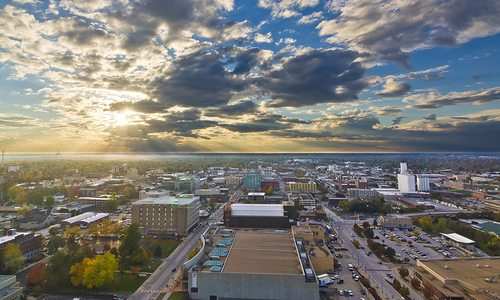Lifestyle
Winds of Change: Five Years After the Joplin Tornado
Five years have passed since the EF-5 tornado ripped its way through Joplin. Since then, the city has rebuilt and even grown, but not every scar has healed.
By Ettie Berneking
May 2016

On May 22, 2011, 13-year-old Emily Huddleston woke up like any other day. When she walked out the front door, she turned back toward the house thinking she had forgotten something. She didn’t know that would be the last time she’d ever see her childhood home.
Five years have passed since the EF-5 tornado ripped through Joplin, leaving behind it a wake of destruction totaling more than $2 billion in damages. At its peak, the tornado spread to be three-quarters-of-a-mile wide. It was a devastating distance that tore 25,000 trees from the ground and left 3 million cubic yards of debris behind. Some 7,500 residential homes were flattened, and 161 people died in the storm. The tornado left its mark not only in Joplin, but in the record books as the seventh deadliest tornado in U.S. history.
Not surprisingly, it has taken Joplin a long time to recover, but slowly the city has managed to pull itself from the rubble. Homes have been rebuilt, new businesses have popped up and trees are blooming, but still, scars remain. For Huddleston, it’s the scar etched across her left thigh that reminds her just how lucky she was.
Surviving the Storm
On the afternoon of May 22, 2011, Huddleston and her family were at graduation when they heard the tornado sirens going off and decided to head home. The family was just a few blocks from their house when the sky turned black, and it looked as if they were about to drive into a wall of rain. It wasn’t rain. Huddleston and her family drove directly into the tornado. “It felt like the start of a roller coaster when you’re jerked up and then you’re off,” Huddleston says. Sucked up into the storm, the car’s windows busted out, and debris engulfed the family. Then, just as suddenly as the storm had scooped them up, it deposited them back on the ground five blocks away. “That’s when we realized my leg was bleeding really badly, and I couldn’t move it,” Huddleston says. With their car totaled, the family piled into another vehicle and sped to Mercy Hospital, but that too had been destroyed.
With Huddleston fading in and out of consciousness, nurses put her on a gurney in the middle of the street and hooked her up to an IV until they were able to load her into the bed of a pickup truck and send her to Freeman Health System hospital. With all the emergency rooms full, Huddleston found herself waiting in the hallway until hospital staff was able to start picking debris out of Huddleston’s leg. That’s when they discovered the cut that inched its way across nearly half of her left thigh was bone-deep. With no operating room available, Huddleston and her mom were loaded into an ambulance, and the emergency crew urged Huddleston to stay awake as they sped to Kansas.
That same afternoon, Joplin High School Principal Dr. Kerry Sachetta was also attending graduation when the tornado sirens sounded. After riding out the storm in a storm shelter, Sachetta drove through the debris to the high school only to find it left in shambles. All around him people were emerging from the rubble as they searched for belongings and family members.
For both Huddleston and Sachetta, their worlds were left in shatters in a matter of minutes. Huddleston lost her childhood home and nearly lost her leg, and Sachetta lost his school and nearly everything in it. That same day, Liz Easton, owner of Cupcakes by Liz, lost both her home and her business. The tornado had flattened her neighborhood and left only the wooden frame of her home standing. “Everything was gone,” Liz says. “It felt like we were the only people on earth.” Not long after, Liz got word that the cupcake shop had also been hit. All that remained was the bakery’s oven and a three-compartment sink.
Down the road, Mercy Hospital had also been hit. The storm blew out all electricity including the hospital’s backup generators. To evacuate the building, 183 patients were led out of the crumbling hospital and carried down stairs in wheelchairs and on doors used as makeshift stretchers. “We probably saw one thousand patients in just two days,” says Shelly Hunter, chief financial officer for Mercy’s Joplin and Kansas hospitals.
Without a command center, hospital staff set up in a nearby parking lot until Memorial Hall was staged to receive patients. “It looked like Armageddon,” Hunter says. “Everything was flattened.” A majority of patients were sent to Freeman Hospital or to hospitals in Springfield, Carthage, Kansas and Arkansas until Mercy could set up a more permanent field hospital. For weeks, Mercy nurses and doctors worked out of a medical tent before moving into portable buildings similar to a trailer house.
As hospital staff tended to the thousands injured by the storm, volunteers started pouring in and local shops and restaurants helped in any way they could. Jason Miller’s restaurant, Instant Karma, had sustained little damage, which meant Miller could still run his kitchen. With so many families reeling from the loss of their homes, loved ones and businesses, Miller switched to a pay-as-you-can system. “People who had lost everything didn’t have to pay at all, while others would pay $30 for a hamburger,” he says. “The one thing I could do to help was cook, so that’s what I did.”

Volunteers and debris fill the streets of Joplin after a EF-5 tornado touched down on May 22, 2011. Photo by Steve Zumwalt/FEMA.
Emerging From the Debris
By January 30, 2014, more than 180,000 volunteers helped rebuild the tattered city, and some 1.5 million hours of service were logged as homes and businesses were rebuilt, including Huddleston’s home.
“All the people who came into Joplin, they made a huge difference,” she says. “Moving back in was a feeling of accomplishment. Like this was one step closer to moving on and one step closer to normal.”
Easton was also able to rebuild and broke ground in the footprint of the destroyed bakery. Within two weeks of starting to rebuild, Cupcakes By Liz was open again, and that sink and stove that had survived the tornado were back in use. As for the Eastons’ home, it was rebuilt just west of their neighborhood.

Hundreds of volunteers joined Joplin’s Habitat for Humanity to build houses in the “Ten for Joplin” project. Photo courtesy Joplin Area Chamber of Commerce.
By 2016, the Joplin Area Habitat for Humanity had completed 105 homes following the tornado, and 14 more homes are planned to be built this year. On top of that, the Joplin Homeowners Assistance Program (J-HAP) has provided $13.65 million of assistance for down-payment and/or closing costs to 450 homebuyers since the program started in 2013. That money went to houses built in the tornado zone, and by this December, J-HAP will come to an end as the last of its funding runs out. “J-HAP was huge,” says Kim Cox, CEO of Ozark Gateway Association of Realtors. “To see it go away is a little bittersweet, but the program was designed to help repopulate the area, and it did that. It increased the number of affordable homes and made a big difference in our community.”
Across the street from Cupcakes by Liz, new housing has popped up, and new restaurants and stores have opened on the corner. But there’s still a lot to be done. Swaths of brown still dot the landscape marking where the tornado landed, and entire neighborhoods still sit vacant. “It’s a creep effect like moss,” Cox says. “The houses are slowly expanding out, but it might be 10 years till those areas fill in.”
Luckily for the Joplin School District, rebuilding has been speedier. Even though 4,000 students lost their classrooms during the storm, Joplin School District beat all expectations and managed to start the 2011–2012 school year on time that August. And when Sachetta and his faculty realized the high school’s supplies were destroyed in the storm, a donation of 2,200 Apple MacBooks took the place of textbooks.
Sachetta himself dug through the debris at the school as he searched for any salvageable supplies. Books and computers were hauled out, including the high school’s collection of school newspapers dating back to the 1920s. After a short amount of time under a few hair dryers, the newspapers were dried out and are now on display in the new high school’s journalism room.
“No one gave up,” Sachetta says. “We all worked together to get things done, and I think we’re in a better place as a district than before the
tornado.”
In January 2014, the new Irving Elementary School, East Middle School and Soaring Heights Elementary Schools re-opened, followed shortly with the opening of Joplin’s new high school in August 2014. To mark that long-awaited milestone, the school was wrapped in a 6-mile-long ribbon that read, “Mission Accomplished.”
But the rebuilding isn’t over yet. In December 2015, Joplin School District’s Early Childhood Center received $10 million to rebuild. Since being flattened by the tornado in 2011, the center has operated completely out of 15 FEMA trailers, but that’s soon to change.
Everywhere you look, evidence of Joplin’s resurgence can be found, including at Mercy Hospital, which opened the doors to its new building in March 2015. Within an hour of it opening, Doctor Jeffrey Manley, medical director of women’s and children’s, delivered the hospital’s first set of twins.
“I’ll never forget that,” he says. Manley, who lived in west Texas and had grown up around tornadoes, got a phone call from Mercy two weeks after the tornado hit. Mercy recruited Manley as a robotics surgeon, and when the hospital called to ask if he still wanted to join the Joplin team, he didn’t hesitate. “I said as long as you have an office for me, I’ll be there.” Of course, for Manley, that office was now housed in a hospital tent.
One year after the tornado left the then St. John’s Regional Medical Center battered and deserted, the five-building campus spreading over 47 acres was finally demolished. “It was a really emotional moment for people who had spent their whole lives here,” Hunter says. But it was also a sign of progress. For a year, the tattered hospital campus stood looming over Joplin as a symbol of sadness.
Two weeks before Mercy’s grand opening, co-workers joined together for a 3-mile remembrance walk from the old campus to the new campus.
Right away, Mercy more than doubled the number of babies delivered in the hospital. Some 100 babies were delivered each month. “It was instant,” Manley says. “We’ve continued growing ever since we moved into the new hospital.”
Part of that growth included a beautiful new NICU equipped with protective hallways with special windows that sustain 250 mph winds. (In 2011, winds reached 212 mph.) Hurricane doors were installed that close during a storm to protect staff and patients from flying glass and debris.
In total, the hospital spent some $20 million on storm hardening. “The tornado was devastating,” Manley says, “but it also gave us the opportunity to do healthcare the right way.” For Manley and Hunter, that means designing the new hospital with the patient in mind.
Instead of whitewashed walls and sterilized ambiance, the new LDRP (labor, delivery, recovery and postpartum) rooms feature bright colors and a spa-like atmosphere and were designed so a mother doesn’t need to transfer to another room following delivery. NICU rooms allow the baby to stay with the family instead of the baby being confined to a nursery.
“This just shows Mercy’s commitment to do it right,” Manley says. “It could have been very simple for them to wash their hands and walk away, but they didn’t. They committed to keeping everyone employed and
rebuilding.”

New houses are still being built in Joplin, especially in the area of Cunningham Park where there was heavy destruction. Photo by Brandon Alms.
Advancing Forward
But Joplin’s rebuilding isn’t over. The city’s new public library is set to open in the spring of 2017, and this year, the city planned the groundbreaking for Kansas City University of Medicine and Biosciences College of Osteopathic Medicine. New parks are being put in, new trees are being planted, new homes are going up, and life in Joplin is returning to normal.
Some even say it’s better than normal, including restaurateur Miller, who saw business at Instant Karma surge after the tornado. “I was new and barely making it as was,” Miller says. “I thought this is probably going to be the straw that breaks the camel’s back.” But it wasn’t. Instead of losing business, Instant Karma was busier than ever. Miller isn’t alone in this newfound boom.
Cupcakes By Liz is thriving, and Joplin’s restaurant and shopping scene is back in full swing. More than 300 new businesses have opened since the tornado struck, and at least 49 restaurants have opened or been rebuilt.
“I call it the Joplin high,” says Jason Wallace, owner of the now-closed Gaslight gastropub. “The tornado gave us a fresh start. A lot of people decided to give back to the city. We’re not runaways. Instead of moving to a bigger city that already has what we like, we are bringing what we like to Joplin and building for the future.”
Even Huddleston, who is now a high school senior, is rooting for the hometown she once desperately wished to leave. “It’s been a challenge,” she says. “There have been times when you just want to move away and move somewhere with trees and other houses and grass, but then you think of everything you went through to get here and how hard the community has worked to rebuild.” It’s been a long journey for everyone, and the road to recovery isn’t over yet.
But just as Joplin proved five years ago, residents here aren’t running away from the challenge, and they continue to work hard to rebuild the city they call home.













